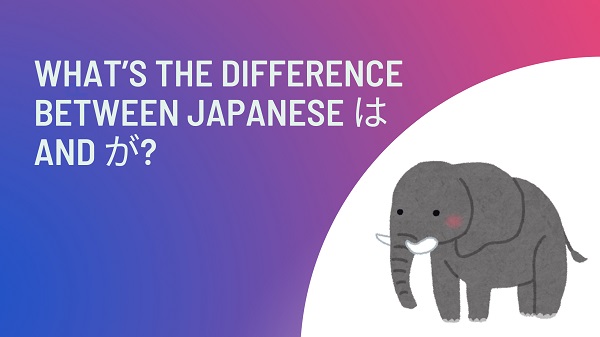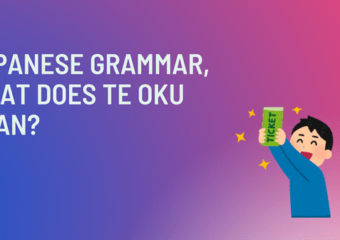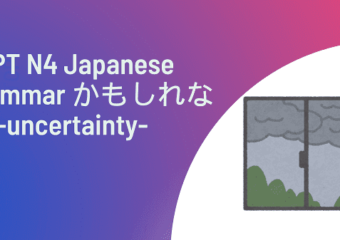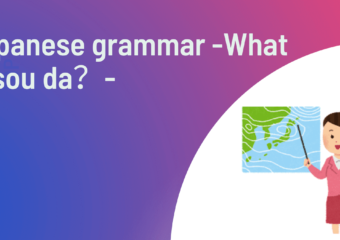Many Japanese learners might be wondering what the difference is between は and が.
In this article, I will teach you the difference.
There are three points for it.
② Rule of は.
③ Rule of が
Let’s learn how to use は and が together!
*Are you looking for a place to practice Japanese?
Youtonihongo is for you.
You may receive one free 30-minute trial lesson.

The free trial class online
We offer online classes and in person classes
Which do you want to focus on?
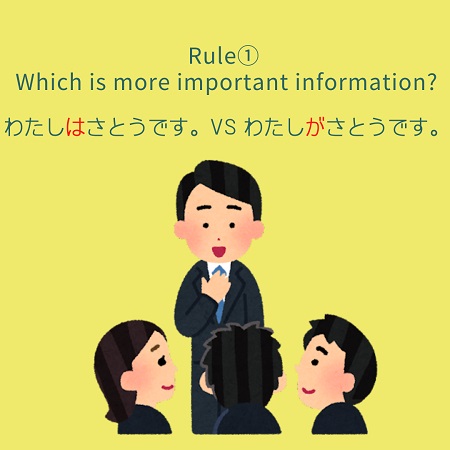
Let’s learn the first point.
If you say A is B, which do you want to focus on more between A and B?
Whether you use は or が depends on it.
How to use は
If you say A is B and you want to focus on B, you use は.
For example, Mr. Sato is asked their name, they say I am Sato.
Which is more important I and Sato?
Of course, Sato is more important information.
That’s why they say わたしはさとうです.
How to use が
If you say A is B and you want to focus on A, you use が.
For instance, someone asked who is Mr. Sato.
Mr. Sato would answer I am Sato.
In this case, “I” is more important information.
In this case, they say わたしがさとうです。
② When you say A is B and want to focus on A, you use が.
Rule of は
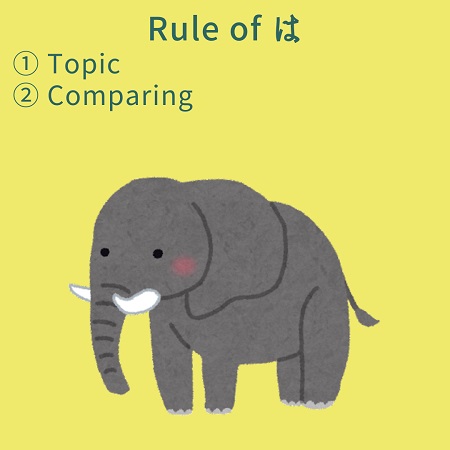
Let’s learn the rule of は.
Mainly, there are two rules for は.
② Comparing
Let’s see each rule.
Topic
は mentions topic, what you are talking about.
For instance,
It’s raining today.
You are talking about today’s weather.
In other words, the topic is about today.
Therefore, you say きょうはあめです.
Let’s see another example.
Literally, it means elephant’s nose is long.
They are talking about ぞう.
Therefore, we use “は” for ぞう.
Comparing
When we compare two things, we use は.
Let’s see one example.
I like mountains, but I don’t like rivers.
In this case, I compare mountains and rivers, so I use “は”.
Let’s see another example.
I ate cake.
This sentence implies that I don’t know if others ate cake or didn’t eat.
I want to tell you one funny story.
There was a friend who changed her hairstyle.
Another friend said きょうは かわいいね to her.
We laughed because it sounded like they said she was cute only today.
Even among Japanese people, these misunderstandings sometimes happen.
Please be careful when you use は, you would add a nuance.
② Comparing
Rule of が
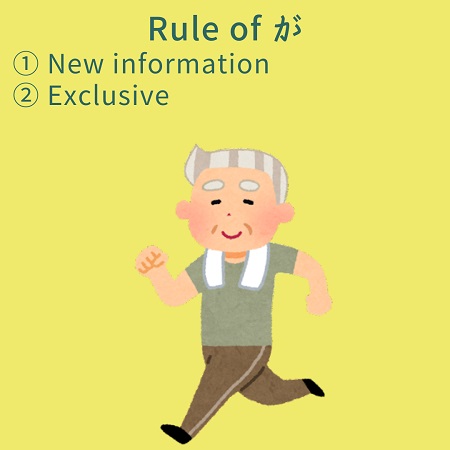
Let’s learn the rule of が
Mainly, there are two rules for が.
② Exclusive
Let’s see each rule.
New information
This rule is similar to “a” and “the”.
If we use a noun for the first time, we use “a”.
After that, we use “the” with the noun.
Let’s see an example.
Sentence1: Long time ago, there was an old man.
Sentence2: The old man went to a mountain.
Please see the first sentence.
We don’t have information about the man, so we use “a” with “man”.
However, in second sentence, we know who we are talking about, so we use “the” with “man”,
Similarly, when we use a noun first time, we use “が”.
After that, we use “は” with the noun.
Sentence1: むかし、おじいさんがいました。
Sentence2: おじいさんは山へ行きました。
In sentence1, we don’t know which old man they are talking about, so we say おじいさんが.
However, in sentence2, we know which old man they are talking about, so we say おじいさんは.
Exclusive
When you say AがB, it means A is the one.
が exclusives others.
Let’s see an example.
I ate cake.
It means only I ate cake and others didn’t.
わたしはケーキをたべました。→ I ate cake and I don’t know if others ate.
わたしがケーキをたべました。→ Only I ate cake and others didn’t.
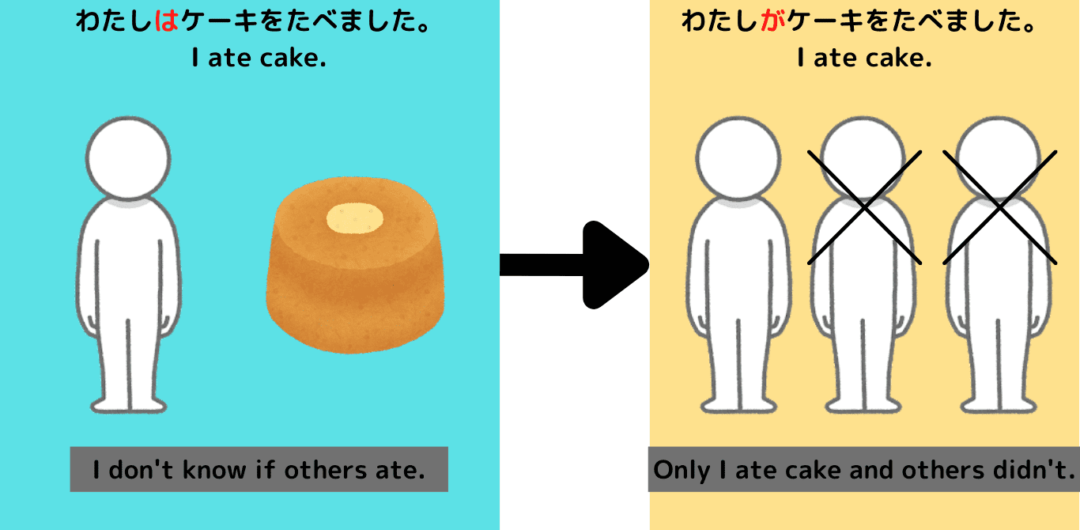
② Exclusive
Conclusion
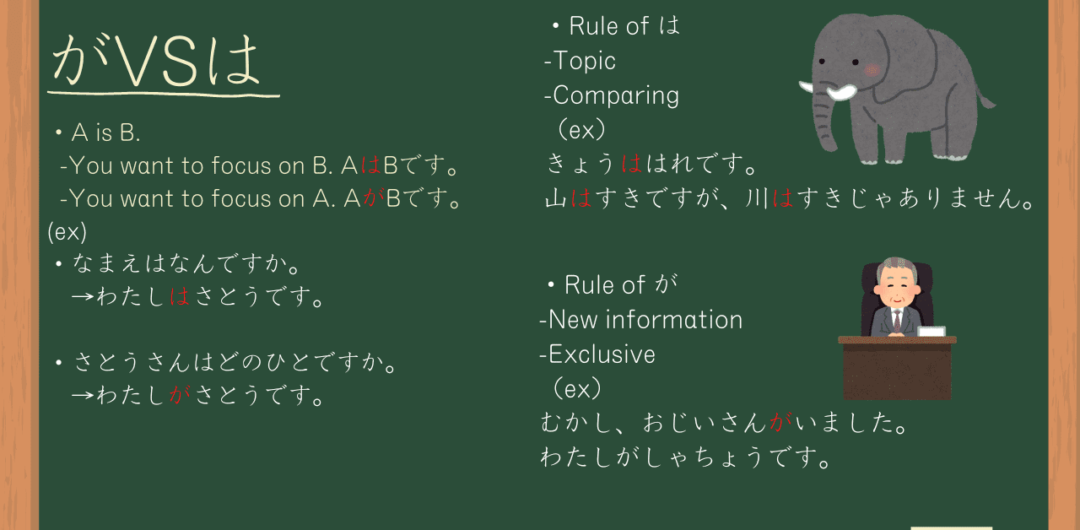
If you say A is B and you want to focus on B, you use は.
If you say A is B and you want to focus on A, you use が.
Rule of は.
-Topic
-Comparing
Rule of が
-New information
-Exclusive
Exercise
①
Q. しゃちょうさんはどのかたですか。
A. わたし( )しゃちょうです。
②
きのう( )ラーメンをたべました。
③
キリン( )くびがながいです。
④
むかし、ここに女の人(1. )すんでいました。
その女の人(2. )いしゃでした。
⑤
だれがケーキをたべましたか。
わたし( )たべました。
Answer
①
Q. しゃちょうさんはどのかたですか。
A. わたし(が)しゃちょうです。
②
きのう(は)ラーメンをたべました。
③
キリン(は)くびがながいです。
④
むかし、ここに女の人(1. が)すんでいました。
その女の人(2. は)いしゃでした。
⑤
だれがケーキをたべましたか。
わたし(が)たべました。
If you have questions, please comment below.
If you’d like to learn more Japanese, please feel free to contact me.
I teach Japanese in-person or online.
You can also learn Japanese on my Instagram page.

The free trial class online
We offer online classes and in person classes
